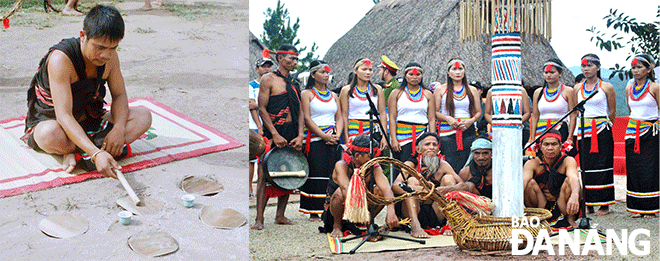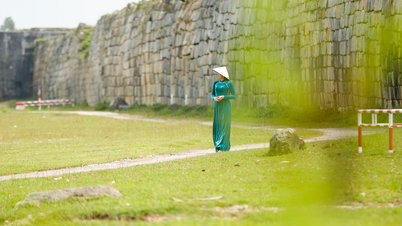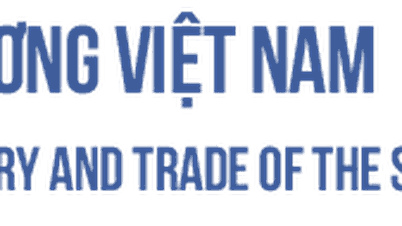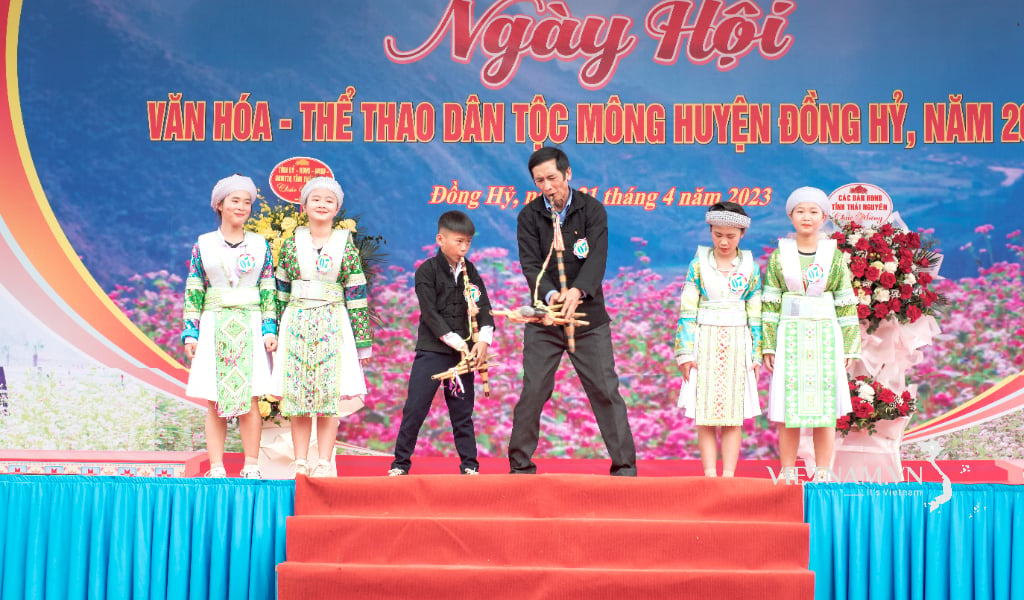The Cor people have many customs and traditions that have been preserved through generations, including the custom of drumming the earth and performing rain-praying rituals, expressing their aspiration to conquer nature; wishing for favorable weather, bountiful harvests, and a peaceful, prosperous, and happy life for the people.
 |
| The Cor people beat earthen drums (left photo) and the rain-praying ceremony takes place beside an outdoor ceremonial pole. Photo: NVS |
The Cor people in Bac Tra My district, Quang Nam province, still preserve the earthen drum – one of the sacred musical instruments considered a treasure of their community. The earthen drum is made from palm sheath and placed over five holes dug in the ground. Each hole is about a handspan wide, long, and deep (about 20cm), shaped like a jar on a flat surface. Each hole is spaced about a handspan apart and arranged in two rows, with two holes in the front row and three in the back. The drumhead is pinned to the ground with four bamboo sticks and then pressed flat against the ground with four bamboo strips. The sound of the earthen drum depends on the tightness of the drumhead, the smoothness, viscosity, and plasticity of the clay, and the diameter, width, and depth of the holes.
Traditionally, before performing the rain-praying ritual, respected village elders would find spacious, flat areas of land to place the earthen drum; then they would search for and select large, mature palm sheaths, dry them, and use them as the drumhead. Usually, only village elders who are knowledgeable about the customs and traditions of the Cor people are allowed to beat the earthen drum during droughts to pray to the heavens for favorable weather and rain.
When the drumstick is struck, the sound travels from the drumhead through the string to the ground. The resulting sounds are a mix of highs and lows, sometimes powerful and resonant, other times soft and gentle. Striking the drumhead with one hand produces a long, sustained sound. Blocking the drumhead with the other hand results in a drier, harsher sound that lacks resonance. Furthermore, the drummer can create sounds that are sometimes boisterous and rapid, and at other times like joyful shouts.
Every year, in the fifth and sixth months of the lunar calendar, after clearing the old fields or clearing new land and completing the planting for the year's crop, the Cor people organize the making of the earth drum and perform a rain-praying ceremony. According to the village elders, the Cor people believe that the earth drum is very sacred in the rain-praying ritual. The villagers pray to five deities: the God of Sky, the God of Clouds, the God of Rain, the God of Earth, and the God of Man, hoping that they will soon grant rain so that all things can flourish, the crops will be abundant, and every household will be prosperous.
Before conducting the rain-praying ceremony, the village elders and shamans meet with the villagers to agree on an auspicious date, the amount of offerings to be contributed, and the method of organizing the ceremony. Depending on the severity of the drought and the conditions of each household and village, the offerings that year may be more or less. However, a ceremonial pole (Cêu) is essential, symbolizing the devotion of the Cor people and serving as the central point for performing the rain-praying ceremony.
The rain-praying ceremony, also known as the water-worshiping ceremony of the goddess Mo Huýt, is held in the center of the village at noon with the presence of all the villagers. Respected village elders, dressed in traditional Cor attire, represent the community and preside over the ceremony, with one elder offering the main prayer. The shaman leads the villagers to worship the Earth God and the Water God. The offerings are simple, consisting of betel nuts and leaves, wine, rice, a boiled chicken, and a young rooster. In addition, dried products such as porcupine or squirrel are indispensable offerings.
As the sounds of gongs and drums resounded, the village elder stepped forward to offer prayers in his native language, expressing his heartfelt devotion to the deities. A rough translation: “Today is an auspicious day, the Cor people offer this offering to the God of Sky, the God of Clouds, the God of Rain, the God of Earth, the God of People, the God of Rivers, the God of Mountains, the God of the Land, and our ancestors. We respectfully ask that you all come and partake. O God of People, call upon the God of Earth, O God of Earth, call upon the God of Sky, O God of Sky, call upon the God of Clouds, so that the God of Rain may save mankind on this earth who are thirsty. Now, the trees are dying and the rivers and streams are drying up, and animals are disappearing. O God of Clouds and God of Rain, quickly pour down water so that the rice plants in the fields may sprout. Please bless us with rain so that the streams and springs may flow, so that the Cor people may have water to drink, for daily life and cooking, so that the cassava, rice, and corn may grow green and the harvest be bountiful.”
After each prayer beside the ceremonial pole, the village elder strikes the drum representing the Earth god once; for the earth drums representing the three gods of Sky, Cloud, and Rain, seven strikes are made; and for the drum representing the God of Man, nine strikes are required. When there is thunder and lightning, the Cor people beat the earth drums and perform the rain-praying ritual until the sky changes to a stormy, ominous sign that rain is coming, only then do they stop.
Through this meaningful folk ritual, the Cor people transmit their moral values and express their dreams of a peaceful life. Alongside this, the festival unfolds with vibrant and lively performances of gong music by young men, accompanied by Cor women in traditional costumes, gracefully dancing the Ka Dau folk dance and singing smooth Cor folk songs. This is also a day of unity for the entire Cor community, bringing people closer together, allowing them to meet, exchange production experiences, inquire about each other's health, and work together to build their homeland and develop their community.
Originating from ancient folk beliefs, the rain-praying ritual of the Cor people is a cultural activity being preserved and promoted. It is significant in strengthening the Cor people's faith, expressing their aspirations for fertility, flourishing plants, and good health. Many cultural values deeply rooted in the Cor ethnic identity are also being restored and nurtured, contributing to the cohesion and inspiring the Cor people, who are simple, vibrant, and hopeful for building a prosperous and beautiful community.
NGUYEN VAN SON
Source link






![[Photo] Prime Minister Pham Minh Chinh presides over a meeting on private sector economic development.](/_next/image?url=https%3A%2F%2Fvphoto.vietnam.vn%2Fthumb%2F1200x675%2Fvietnam%2Fresource%2FIMAGE%2F2025%2F12%2F20%2F1766237501876_thiet-ke-chua-co-ten-40-png.webp&w=3840&q=75)


























































































Comment (0)